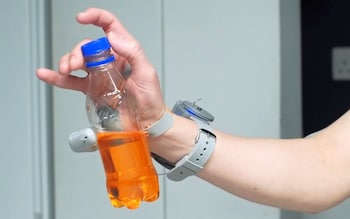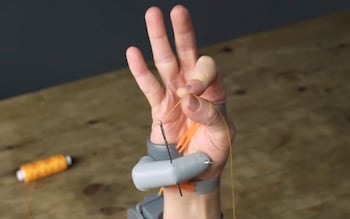<p>Invention is controlled by pressure sensors under the feet and is being tested by Cambridge University before eventually being marketed</p>

The thumb being used to open a bottle single-handedly
“The third thumb is often most useful in your everyday life when you are holding multiple items whilst trying to perform a task,and you think ‘I just need an extra pair of hands’,” said Prof Tamar Makin,of the Medical Research Council (MRC) Cognition and Brain Sciences Unit at Cambridge.
“For example,if you’re trying to hold the lead of your dog,whilst you’re also holding a coffee cup and your phone,and at the same time you’re trying to get your keys out of your pocket.
“It’s these types of everyday scenarios,where having the third thumb available to help hold one of these items would be a big help.”
Footage released by the university shows the thumb being used to open a bottle single-handedly,hold an egg while cracking another egg into a bowl,and carrying wine glasses and a bottle in one hand.
The team also believe it would be invaluable for tricky manual tasks such as soldering or performing surgery.
In a new trial,596 members of the public of different ages and sexes were invited to test the robotic thumb by either moving pegs into a basket or manipulating foam objects.
Almost everyone was able to use the device straight away and 98 per cent of participants were able to successfully manipulate objects using the thumb during the first minute of use.
Just four people were unable to get to grips with the prosthetic thumb,either because it did not fit,or they were too light to activate the feet sensors.

The thumb used to assist with sewing
Older and younger adults had a similar level of ability when using the technology,although there was a decline in the performance of the elderly with increasing age.
Motor augmentation is a growing field,which aims to use exoskeletons or robotic parts to allow humans to overcome biological limitations,such as strength,speed or dexterity.
The thumb is an obvious choice as the evolution of opposable thumbs allowed our human ancestors to manipulate stone and wood into tools,which helped drive the dominance of the species.
Cambridge said that it is still in the research and design process,but is hoping to eventually market the thumb.
Lucy Dowdall,of the MRC Cognition and Brain Science Unit,said: “The current study was geared towards demonstrating the feasibility of our technology – we showed that pretty much anyone who wants to use the thumb can,and can figure out how to use it very quickly.
“This level of evidence goes a long way towards commercialisation,but we are not quite there yet. We are currently in the R&D phase with a working prototype that has been extensively tested.
“Our focus remains on refining the technology and ensuring it meets the highest standards of functionality,safety,and user adaptability,as well as using it as a model to explore augmentation in the neuroscience research space.”
The results of the trial were published in the journal Science Robotics.

© Singapore Technology Information Privacy Policy Contact us